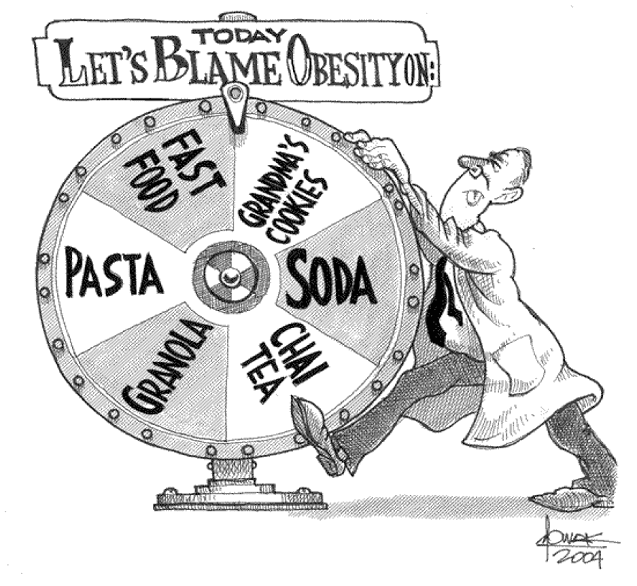According to new research from University of Virginia economist Federico Ciliberto, widespread adoption of genetically modified crops has decreased the use of insecticides, but increased the use of weed-killing herbicides as weeds become more resistant.
Ciliberto led the largest study of genetically modified crops and pesticide use to date, alongside Edward D. Perry of Kansas State University, David A. Hennessy of Michigan State University and GianCarlo Moschini of Iowa State University. The four economists studied annual data from more than 5,000 soybean and 5,000 maize farmers in the U.S. from 1998 to 2011, far exceeding previous studies that have been limited to one or two years of data.
The widespread adoption of genetically engineered (GE) crops has clearly led to changes in pesticide use, but the nature and extent of these impacts remain open questions. We study this issue with a unique, large, and representative sample of plot-level choices made by U.S. maize and soybean farmers from 1998 to 2011. On average, adopters of GE glyphosate-tolerant (GT) soybeans used 28% (0.30 kg/ha) more herbicide than nonadopters, adopters of GT maize used 1.2% (0.03 kg/ha) less herbicide than nonadopters, and adopters of GE insect-resistant (IR) maize used 11.2% (0.013 kg/ha) less insecticide than nonadopters. When pesticides are weighted by the environmental impact quotient, however, we find that (relative to nonadopters) GE adopters used about the same amount of soybean herbicides, 9.8% less of maize herbicides, and 10.4% less of maize insecticides. In addition, the results indicate that the difference in pesticide use between GE and non-GE adopters has changed significantly over time. For both soybean and maize, GT adopters used increasingly more herbicides relative to nonadopters, whereas adopters of IR maize used increasingly less insecticides. The estimated pattern of change in herbicide use over time is consistent with the emergence of glyphosate weed resistance.
“The fact that we have 14 years of farm-level data from farmers all over the U.S. makes this study very special,” Ciliberto said. “We have repeated observations of the same farmers and can see when they adopted genetically modified seeds and how that changed their use of chemicals.”

Since 2008, genetically engineered crops have accounted for more than 80 percent of maize and soybean crops planted in the U.S. Maize seeds are modified with two genes: one kills insects that eat the seed and one allows the seed to tolerate glyphosate, a herbicide commonly used in weed killers like Roundup. Soybeans are modified with just one glyphosate-resistant gene.
Unsurprisingly, maize farmers who used the insect-resistant seeds used significantly less insecticide – about 11.2 percent less – than farmers who did not use genetically modified maize. The maize farmers also used 1.3 percent less herbicide over the 13-year period.
Soybean crops, on the other hand, saw a significant increase in herbicide use, with adopters of genetically modified crops using 28 percent more herbicides than non-adopters.
Ciliberto attributes this increase to the proliferation of glyphosate-resistant weeds.
“In the beginning, there was a reduction in herbicide use, but over time the use of chemicals increased because farmers were having to add new chemicals as weeds developed a resistance to glyphosate,” Ciliberto said.
 Maize farmers, he said, have not yet had to address the same level of resistance, in part because they did not adopt genetically modified crops as quickly as their counterparts in the soy industry. However, the study did find evidence that both maize and soybean farmers increased herbicide use during the last five years of the study, indicating that weed resistance is a growing problem for both groups.
Maize farmers, he said, have not yet had to address the same level of resistance, in part because they did not adopt genetically modified crops as quickly as their counterparts in the soy industry. However, the study did find evidence that both maize and soybean farmers increased herbicide use during the last five years of the study, indicating that weed resistance is a growing problem for both groups.
From 2006 to 2011, the percentage of hectares sprayed with only glyphosate shrunk from more than 70 percent to 41 percent for soybean farmers and from more than 40 percent to 19 percent for maize farmers. The decrease resulted from farmers having to resort to other chemicals as glyphosate-resistant weeds became more common.
“Evidence suggests that weeds are becoming more resistant and farmers are having to use additional chemicals, and more of them,” Ciliberto said.
Insects do not appear to have developed a similar resistance, in part because federal regulations require farmers to have a “safe haven” in their fields that is free of genetically modified crops. Insects and worms in those safe havens have no need to develop resistance, and because they interact and breed with insects in other parts of the field, they help prevent the development of resistant genes.
Despite the decrease in insecticide use, continued growth in herbicide use poses a significant environmental problem as large doses of the chemicals can harm biodiversity and increase water and air pollution.
Ciliberto and his colleagues measured the overall environmental impact of the changes in chemical use that have resulted from the adoption of genetically modified crops, using a measure called the environmental impact quotient, or EIQ, to account for chemicals’ impact on farmworkers, consumers and the environment. Comparing adopters to non-adopters, they found little change in the impact on farmworkers and consumers. However, the adoption of genetically modified soybeans correlated with a negative impact on the environment as increased herbicide use also increased contamination of local ecosystems.
Overall, Ciliberto said he was surprised by the extent to which herbicide use had increased and concerned about the potential environmental impact.
“I did not expect to see such a strong pattern,” he said.
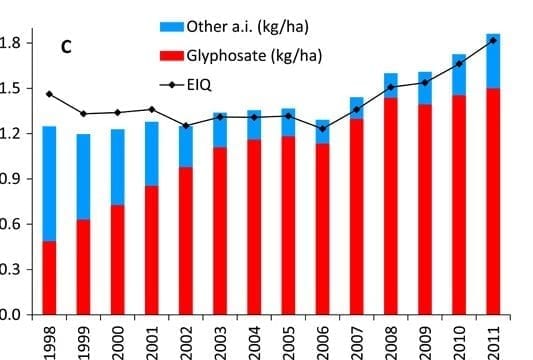
Dr. Mercola has an article on the harmful effects of glyphosate below:
We’ve learned some very disturbing truths about glyphosate, the active ingredient in Monsanto’s broad-spectrum herbicide Roundup, which is generously doused on genetically engineered (GE) Roundup Ready crops.
GE crops are typically far more contaminated with glyphosate than conventional crops, courtesy of the fact that they’re engineered to withstand extremely high levels of Roundup without perishing along with the weed.
A 2013 peer-reviewed report authored by Anthony Samsel, a retired science consultant, and a long time contributor to the Mercola.com Vital Votes Forum, and Dr. Stephanie Seneff, a research scientist at the Massachusetts Institute of Technology (MIT), reveals how glyphosate wrecks human health.
In the interview above, Dr. Seneff summarizes the two key problems caused by glyphosate in the diet:
- Nutritional deficiencies
- Systemic toxicity
Their findings make the need for labeling all the more urgent, and the advice to buy certified organic all the more valid.
The Horrific Truth about Roundup
In 2009, a French court found Monsanto guilty of lying; falsely advertising its Roundup herbicide as “biodegradable,” “environmentally friendly” and claiming it “left the soil clean.”
Mounting evidence now tells us just how false such statements are. I don’t believe that Monsanto is one of the most evil companies on the planet for nothing. The company has done absolutely nothing to improve their worldwide influence on human and environmental health.
In the video above, Jeffrey Smith, author of the bestseller Seeds of Deception,says Monsanto, during some reflective moment, must have asked “What would Darth Vader do?” Because what they’ve come up with is a way of pretending that they’re beneficial and then insinuating themselves into the food and agriculture industry, and now it turns out that what they have is very, very dangerous.
Indeed, according to Dr. Seneff, glyphosate is possibly “the most important factor in the development of multiple chronic diseases and conditions that have become prevalent in Westernized societies,” including but not limited to:
| Autism | Gastrointestinal diseases such as inflammatory bowel disease, chronic diarrhea, colitis and Crohn’s disease | Obesity |
| Allergies | Cardiovascular disease | Depression |
| Cancer | Infertility | Alzheimer’s disease |
| Parkinson’s disease | Multiple sclerosis | ALS, and more |
How Glyphosate Worsens Modern Diseases
While Monsanto insists that Roundup is as safe to humans as aspirin, Seneff and Samsel’s research tells a different story altogether. Their report, published in the journal Entropy1, argues that glyphosate residues, found in most commonly consumed foods in the Western diet courtesy of GE sugar, corn, soy and wheat, “enhance the damaging effects of other food-borne chemical residues and toxins in the environment to disrupt normal body functions and induce disease.”
Interestingly, your gut bacteria are a key component of glyphosate’s mechanism of harm.
Monsanto has steadfastly claimed that Roundup is harmless to animals and humans because the mechanism of action it uses (which allows it to kill weeds), called the shikimate pathway, is absent in all animals. However, the shikimate pathway IS present in bacteria, and that’s the key to understanding how it causes such widespread systemic harm in both humans and animals.
The bacteria in your body outnumber your cells by 10 to 1. For every cell in your body, you have 10 microbes of various kinds, and all of them have the shikimate pathway, so they will all respond to the presence of glyphosate!
Glyphosate causes extreme disruption of the microbe’s function and lifecycle. What’s worse, glyphosate preferentially affects beneficial bacteria, allowing pathogens to overgrow and take over. At that point, your body also has to contend with the toxins produced by the pathogens. Once the chronic inflammation sets in, you’re well on your way toward chronic and potentially debilitating disease. In the interview above, Dr. Seneff reviews a variety of chronic diseases, explaining how glyphosate contributes to each condition. So to learn more, I urge you to listen to it in its entirety. It’s quite eye-opening.
The Overlooked Component of Toxicity
The research reveals that glyphosate inhibits cytochrome P450 (CYP) enzymes, a large and diverse group of enzymes that catalyze the oxidation of organic substances. This, the authors state, is “an overlooked component of its toxicity to mammals.” One of the functions of CYP enzymes is to detoxify xenobiotics—chemical compounds found in a living organism that are not normally produced or consumed by the organism in question. By limiting the ability of these enzymes to detoxify foreign chemical compounds, glyphosate enhances the damaging effects of chemicals and environmental toxins you may be exposed to.
But that’s not all. Dr. Stephanie Seneff has been conducting research at MIT for over three decades. She also has an undergraduate degree in biology from MIT and a minor in food and nutrition, and I have previously interviewed her about her groundbreaking insights into the critical importance of sulfur in human health. Not surprisingly, this latest research also touches on sulfur, and how it is affected by glyphosate from food.
“[W]e show how interference with CYP enzymes acts synergistically with disruption of the biosynthesis of aromatic amino acids by gut bacteria, as well as impairment in serum sulfate transport,” the authors write.
“Consequences are most of the diseases and conditions associated with a Western diet, which include gastrointestinal disorders, obesity, diabetes, heart disease, depression, autism, infertility, cancer and Alzheimer’s disease. … [T]he recent alarming increase in all of these health issues can be traced back to a combination of gut dysbiosis, impaired sulfate transport, and suppression of the activity of the various members of the cytochrome P450 (CYP) family of enzymes.”
The Roundup-Autism Connection
For the past 30 years, Dr. Seneff has been passionate about teasing out potential causes of autism, after seeing what it was like for a close friend whose son was diagnosed. She points out the clear correlations between increased glyphosate use over recent years (the result of genetically engineered crops causing weed resistance, necessitating ever-larger amounts to be used) and skyrocketing autism rates.
The rate of autism has risen so quickly, there can be no doubt that it has an environmental cause. Our genes simply cannot mutate fast enough to account for the rapid rise we’re now seeing. The latest statistics released by the CDC on March 20 show that 1 in 50 children in the US now fall within the autism spectrum2,3 with a 5:1 boy to girl ratio. Just last year the CDC reported a rate of 1 in 88, which represented a 23 percent increase since 2010, and 78 percent since 2007. Meanwhile, I remember when the incidence of autism in the US was only 1 in 10,000—just short of 30 years ago!
Dr. Seneff identified two key problems in autism that are unrelated to the brain yet clearly associated with the condition—both of which are linked with glyphosate exposure (starting at 10 minutes into the interview, she gives an in-depth explanation of how glyphosate causes the many symptoms associated with autism):
- Gut dysbiosis (imbalances in gut bacteria, inflammation, leaky gut, food allergies such as gluten intolerance)
- Disrupted sulfur metabolism / sulfur and sulfate deficiency
Interestingly, certain microbes in your body actually break down glyphosate, which is a good thing. However, a byproduct of this action is ammonia, and children with autism tend to have significantly higher levels of ammonia in their blood than the general population. Ditto for those with Alzheimer’s disease. In your brain, ammonia causes encephalitis, i.e. brain inflammation.
Another devastating agent you really do not want in your body is formaldehyde, which a recent nutritional analysis discovered is present in genetically engineered corn at a level that is 200 times the amount that animal studies have determined to be toxic to animals. Formaldehyde destroys DNA and can cause cancer.
 Other research backing up the Roundup-autism link is that from former US Navy staff scientist Dr. Nancy Swanson. She has a Ph.D. in physics, holds five US patents and has authored more than 30 scientific papers and two books on women in science. Ten years ago, she became seriously ill, and in her journey to regain her health she turned to organic foods. Not surprisingly (for those in the know) her symptoms dramatically improved. This prompted her to start investigating genetically engineered foods.
Other research backing up the Roundup-autism link is that from former US Navy staff scientist Dr. Nancy Swanson. She has a Ph.D. in physics, holds five US patents and has authored more than 30 scientific papers and two books on women in science. Ten years ago, she became seriously ill, and in her journey to regain her health she turned to organic foods. Not surprisingly (for those in the know) her symptoms dramatically improved. This prompted her to start investigating genetically engineered foods.
She has meticulously collected statistics on glyphosate usage and various diseases and conditions, including autism. A more perfect match-up between the rise in glyphosate usage and incidence of autism is hard to imagine… To access her published articles and reports, please visit Sustainable Pulse4, a European website dedicated to exposing the hazards of genetically engineered foods.
When Food is Poison
What the biotech industry, spearheaded by Monsanto, has managed to do is turn food into poison… quite literally, and in more ways than one. Here, we’re just talking about the effects of Roundup. There are plenty of indications that the genetic alteration of a crop itself can pose significant health concerns. So with the vast majority of GE crops, you have no less than two potentially hazardous factors to contend with, glyphosate toxicity being just one part of the equation.
As discussed above, glyphosate has a number of devastating biological effects. So much so that it may very well be one of the most important factors in the development of a wide variety of modern diseases and conditions, including autism. In summary, these detrimental effects include:
Nutritional deficiencies, as glyphosate immobilizes certain nutrients and alters the nutritional composition of the treated crop Disruption of the biosynthesis of aromatic amino acids (these are essential amino acids not produced in your body that must be supplied via your diet) Increased toxin exposure (this includes high levels of glyphosate and formaldehyde in the food itself) Impairment of sulfate transport and sulfur metabolism; sulfate deficiency Systemic toxicity—a side effect of extreme disruption of microbial function throughout your body; beneficial microbes in particular, allowing for overgrowth of pathogens Gut dysbiosis (imbalances in gut bacteria, inflammation, leaky gut, food allergies such as gluten intolerance) Enhancement of damaging effects of other food-borne chemical residues and environmental toxins as a result of glyphosate shutting down the function of detoxifying enzymes Creation of ammonia (a byproduct created when certain microbes break down glyphosate), which can lead to brain inflammation associated with autism and Alzheimer’s disease
How to Protect Yourself and Your Family from This Systemic Poison
It’s important to understand that the glyphosate sprayed on conventional and genetically engineered crops actually becomes systemic throughout the plant, so it cannot be washed off. It’s inside the plant. For example, genetically engineered corn has been found to contain 13 ppm of glyphosate, compared to zero in non-GMO corn. At 13 ppm, GMO corn contains more than 18 times the “safe” level of glyphosate set by the EPA. Organ damage in animals has occurred at levels as low as 0.1 ppm. If that’s not reason enough to become a label reader to avoid anything with corn in it, such as corn oil or high fructose corn syrup, I don’t know what is.
You’d also be wise to stop using Roundup around your home, where children and pets can come into contact with it simply by walking across the area.
Until the US requires genetically engineered (GE) foods to be labeled, the only way you can avoid GE ingredients is to make whole, fresh organic foods the bulk of your diet, and to only buy 100% USDA certified organic processed foods. Meats need to be grass-fed or pastured to make sure the animals were not fed GE corn or soy feed.
Last but not least, do not confuse the “natural” label” with organic standards.
The natural label is not based on any standards and is frequently misused by sellers of GE products. Growers and manufacturers of organic products bearing the USDA seal, on the other hand, have to meet the strictest standards of any of the currently available organic labels. In order to qualify as organic, a product must be grown and processed using organic farming methods that recycle resources and promote biodiversity. Crops must be grown without synthetic pesticides, bioengineered genes, petroleum-based fertilizers, or sewage sludge-based fertilizers.
Source: advances.sciencemag.org, mercola.com, uva.edu
Recommended Book:
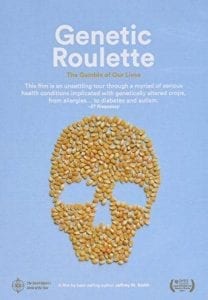 DVD Documentary: Never-Before-Seen-Evidence points to genetically engineered foods as a major contributor to rising disease rates in the US population, especially among children. Gastrointestinal disorders, allergies, inflammatory diseases, and infertility are just some of the problems implicated in humans, pets, livestock, and lab animals that eat genetically modified soybeans and corn. Monsanto’s strong arm tactics, the FDA’s fraudulent policies, and how the USDA ignores a growing health emergency are also laid bare. This sometimes shocking film may change your diet, help you protect your family, and accelerate the consumer tipping point against genetically modified organisms (GMOs). Don’t miss this film! The main feature film Genetic Roulette is 85 minutes. The package also contains a bonus DVD with: Seeds of Freedom (28 min) Narrated by Jeremy Irons, produced by The Gaia Foundation and African Biodiversity Network, this landmark film shows how the story of seed at the hands of multinationals has become one of loss, control, dependence and debt. More information about the Seeds of Freedom can be found here. The Documented Health Risks of Genetically Engineered Foods (42 min) Jeffrey Smith presents a concise, hard-hitting talk to more than 800 healthcare practitioners at Andrew Weil’s Arizona Center for Integrated Medicine conference in 2011. The Politics of GMOs (16 min) This presentation excerpt describes the unholy alliance between the US government and Monsanto, as well as some highlights of Monsanto’s dark history. 12 Short Public Service Announcements All content in the bonus disk can be played on television without charge or special permission.
DVD Documentary: Never-Before-Seen-Evidence points to genetically engineered foods as a major contributor to rising disease rates in the US population, especially among children. Gastrointestinal disorders, allergies, inflammatory diseases, and infertility are just some of the problems implicated in humans, pets, livestock, and lab animals that eat genetically modified soybeans and corn. Monsanto’s strong arm tactics, the FDA’s fraudulent policies, and how the USDA ignores a growing health emergency are also laid bare. This sometimes shocking film may change your diet, help you protect your family, and accelerate the consumer tipping point against genetically modified organisms (GMOs). Don’t miss this film! The main feature film Genetic Roulette is 85 minutes. The package also contains a bonus DVD with: Seeds of Freedom (28 min) Narrated by Jeremy Irons, produced by The Gaia Foundation and African Biodiversity Network, this landmark film shows how the story of seed at the hands of multinationals has become one of loss, control, dependence and debt. More information about the Seeds of Freedom can be found here. The Documented Health Risks of Genetically Engineered Foods (42 min) Jeffrey Smith presents a concise, hard-hitting talk to more than 800 healthcare practitioners at Andrew Weil’s Arizona Center for Integrated Medicine conference in 2011. The Politics of GMOs (16 min) This presentation excerpt describes the unholy alliance between the US government and Monsanto, as well as some highlights of Monsanto’s dark history. 12 Short Public Service Announcements All content in the bonus disk can be played on television without charge or special permission.
 Are GMOs really that bad? A prominent environmental journalist takes a fresh look at what they actually mean for our food system and for us.
Are GMOs really that bad? A prominent environmental journalist takes a fresh look at what they actually mean for our food system and for us.
In the past two decades, GMOs have come to dominate the American diet. Advocates hail them as the future of food, an enhanced method of crop breeding that can help feed an ever-increasing global population and adapt to a rapidly changing environment. Critics, meanwhile, call for their banishment, insisting GMOs were designed by overeager scientists and greedy corporations to bolster an industrial food system that forces us to rely on cheap, unhealthy, processed food so they can turn an easy profit. In response, health-conscious brands such as Trader Joe’s and Whole Foods have started boasting that they are “GMO-free,” and companies like Monsanto have become villains in the eyes of average consumers.
Where can we turn for the truth? Are GMOs an astounding scientific breakthrough destined to end world hunger? Or are they simply a way for giant companies to control a problematic food system?
Environmental writer McKay Jenkins traveled across the country to answer these questions and discovered that the GMO controversy is more complicated than meets the eye. He interviewed dozens of people on all sides of the debate—scientists hoping to engineer new crops that could provide nutrients to people in the developing world, Hawaiian papaya farmers who credit GMOs with saving their livelihoods, and local farmers in Maryland who are redefining what it means to be “sustainable.” The result is a comprehensive, nuanced examination of the state of our food system and a much-needed guide for consumers to help them make more informed choices about what to eat for their next meal.
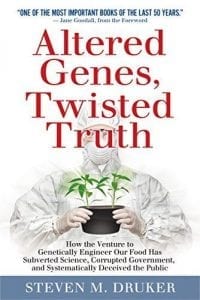 This book uncovers the biggest scientific fraud of our age. It tells the fascinating and frequently astounding story of how the massive enterprise to restructure the genetic core of the world’s food supply came into being, how it advanced by consistently violating the protocols of science, and how for more than three decades, hundreds of eminent biologists and esteemed institutions have systematically contorted the truth in order to conceal the unique risks of its products–and get them onto our dinner plates.
This book uncovers the biggest scientific fraud of our age. It tells the fascinating and frequently astounding story of how the massive enterprise to restructure the genetic core of the world’s food supply came into being, how it advanced by consistently violating the protocols of science, and how for more than three decades, hundreds of eminent biologists and esteemed institutions have systematically contorted the truth in order to conceal the unique risks of its products–and get them onto our dinner plates.
Altered Genes, Twisted Truth provides a graphic account of how this elaborate fraud was crafted and how it not only deceived the general public, but Bill Clinton, Bill Gates, Barack Obama and a host of other astute and influential individuals as well. The book also exposes how the U.S. Food and Drug Administration (FDA) was induced to become a key accomplice–and how it has broken the law and repeatedly lied in order to usher genetically engineered foods onto the market without the safety testing that’s required by federal statute. As a result, for fifteen years America’s families have been regularly ingesting a group of novel products that the FDA’s own scientific staff had previously determined to be unduly hazardous to human health.
By the time this gripping story comes to a close, it will be clear that the degradation of science it documents has not only been unsavory but unprecedented–and that in no other instance have so many scientists so seriously subverted the standards they were trained to uphold, misled so many people, and imposed such magnitude of risk on both human health and the health of the environment.
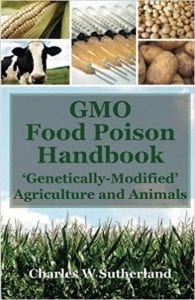 “GMO crops are scientifically created to BE poisonous and to ABSORB poison.”
“GMO crops are scientifically created to BE poisonous and to ABSORB poison.”
“The American chemical industry, having taken control of agriculture, has achieved something never before accomplished in the history of mankind: humans who are simultaneously overfed and undernourished…and poisoned.”
The GMO Food Poison Handbook is a summary of GMOs (genetically modified organisms), ‘food products’ created by Monsanto and other chemical companies. In simple terms it describes how the various GMO ‘food products’ create biological and medical problems, including birth defects, cancer, and diabetes.
To better inform the reader, the Handbook provides simple descriptions of 20 body organs which are affected, as well as the nature of allergies, obesity, and cancer – and the male and female reproductive organs, including the fetus in the womb. As an interesting part of the description, the function of each body part is explained – so the Handbook is also a ‘Biology for Beginners’ in clearly explaining basic biology with illustrations.
Most disturbing are the results of studies which reveal that these GMO ‘food’ toxins remain inside of our intestines and continuously reproduce!
The reader will also learn how the GMO crops poison the world’s soil, water, and air, and destroy the natural habitat of bacteria, bees, and fish.
A ready reference book, the GMO Food Poison Handbook provides a clear summary of studies from renowned research scientists in thirty (30) countries (with links to those studies for those who wish to see them in depth), and comments from journalists around the world.
If you eat, you will want to read this book!
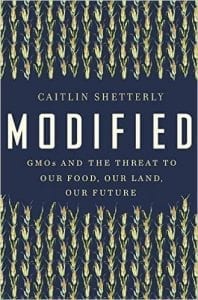 A disquieting and meditative look at the issue that started the biggest food fight of our time–GMOs. From a journalist and mother who learned that genetically modified corn was the culprit behind what was making her and her child sick, a must-read book for anyone trying to parse the incendiary discussion about genetically modified foods.
A disquieting and meditative look at the issue that started the biggest food fight of our time–GMOs. From a journalist and mother who learned that genetically modified corn was the culprit behind what was making her and her child sick, a must-read book for anyone trying to parse the incendiary discussion about genetically modified foods.
GMO products are among the most consumed and the least understood substances in the United States today. They appear not only in the food we eat, but in everything from the interior coating of paper coffee cups and medicines to diapers and toothpaste. We are often completely unaware of their presence.
Caitlin Shetterly discovered the importance of GMOs the hard way. Shortly after she learned that her son had an alarming sensitivity to GMO corn, she was told that she had the same condition, and her family’s daily existence changed forever. An expansion of Shetterly’s viral Elle article “The Bad Seed,”Modified delves deep into the heart of the matter—from the cornfields of Nebraska to the beekeeping conventions in Brussels—to shine a light on the people, the science, and the corporations behind the food we serve ourselves and our families every day. Deeper than an exposé, and written by a mother and journalist whose journey had no agenda other than to understand the nuance and confusion behind GMOs, Modified is a rare breed of book that will at once make you weep at the majestic beauty of our Great Plains and force you to harvest deep seeds of doubt about the invisible monsters currently infiltrating our food and our land and threatening our future.
There are 3 types of food in the United States.
1) Organic food,
2) Old-fashioned, conventional, non-GMO food.
3) GMO (genetically engineered) food
How do I know which food is GMO and which food is the regularly priced, old-fashioned, conventional, non-GMO food? I had played with GMO fire and every time I got burned. This book is my story about my tragic decline and my uprising efforts to heal myself.



